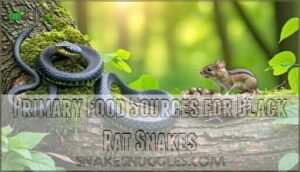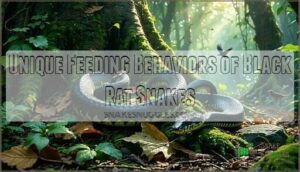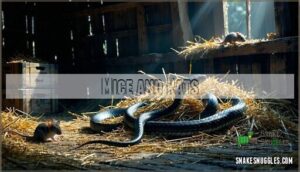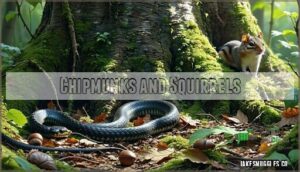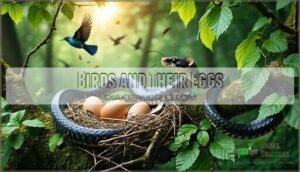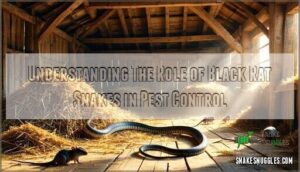This site is supported by our readers. We may earn a commission, at no cost to you, if you purchase through links.
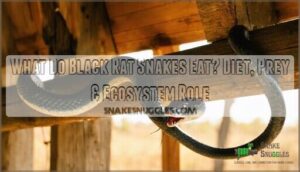 A black rat snake coiling around a barn rafter isn’t just looking for a place to rest—it’s positioning itself near one of nature’s most reliable food sources. These skilled constrictors have earned their name through centuries of hunting rodents in agricultural buildings, but their menu extends far beyond rats and mice.
A black rat snake coiling around a barn rafter isn’t just looking for a place to rest—it’s positioning itself near one of nature’s most reliable food sources. These skilled constrictors have earned their name through centuries of hunting rodents in agricultural buildings, but their menu extends far beyond rats and mice.
From raiding bird nests thirty feet up in oak trees to snatching frogs along creek banks, black rat snakes adapt their hunting strategies to whatever prey crosses their path. Understanding what fuels these impressive predators reveals why farmers once welcomed them into barns and why they remain essential players in controlling pest populations across eastern North America.
Table Of Contents
- Key Takeaways
- Black Rat Snake Diet Overview
- Primary Food Sources for Black Rat Snakes
- Unique Feeding Behaviors of Black Rat Snakes
- Common Prey Items of Black Rat Snakes
- Feeding Patterns and Seasonal Variations
- Impact of Black Rat Snakes on Ecosystems
- Understanding The Role of Black Rat Snakes in Pest Control
- Frequently Asked Questions (FAQs)
- What do black rat snakes eat?
- What do black snakes eat?
- What do western rat snakes eat?
- Do black rat snakes eat birds?
- Do black rat snakes eat Eagles?
- What do rat snakes eat in captivity?
- How do black rat snakes catch and subdue their prey?
- How do black rat snakes hunt at night?
- Do black rat snakes need water after eating?
- How long does digestion take for rat snakes?
- Conclusion
Key Takeaways
- Black rat snakes demonstrate remarkable dietary flexibility by consuming primarily small mammals (64% of diet), but they shift to birds and eggs during the May-August nesting season when these items can comprise up to 42% of their prey intake.
- These constrictors serve as highly effective natural pest control agents, consuming 70-80 rodents annually per snake across a three-acre area, which translates to measurable reductions in crop damage and rodent populations without chemical intervention.
- Black rat snakes rank as the leading nest predators in fragmented forests (responsible for roughly 38% of depredations), using primarily nocturnal hunting strategies that result in 75% mortality rates for incubating female birds during nest raids.
- Their feeding patterns follow dramatic seasonal variations, with adults eating every 7-14 days during warm months while entering complete dormancy during winter brumation, relying entirely on stored fat reserves for survival.
Black Rat Snake Diet Overview
If you’ve ever wondered what fuels a black rat snake’s survival, you’re about to find out. These adaptable constrictors have evolved to consume a surprisingly diverse menu of prey items.
Here’s what drives their diet: their feeding habits, what they prefer to hunt, and their eating schedule.
General Feeding Habits
Black rat snakes hunt wherever food is abundant, shifting their diet to match whatever’s available—rodents in the brush, birds in the trees, or amphibians near water.
This flexibility in what they eat is part of what makes them so successful across different environments.
These constrictors showcase specific hunting strategies:
- Ambush predation – waiting motionless near rodent trails or bird nests
- Active foraging – exploring tree cavities and ground burrows systematically
- Scent-based tracking – using their keen sense of smell to locate hidden prey
By adjusting what they eat based on what’s around, black rat snakes help keep small mammal, bird, and amphibian numbers in check across their range.
Prey Selection
Black rat snakes are opportunistic eaters with a remarkably flexible diet. Small mammals make up most of their meals throughout the year, but during nesting season—May through August—birds and eggs become prime targets, accounting for roughly 42% of their prey in June.
Adult snakes will hunt chipmunks, squirrels, and even young rabbits, though they still catch smaller prey when the opportunity arises.
Amphibians and reptiles don’t show up on the menu as often, though young snakes sometimes eat each other—which helps thin out competition.
Rather than sticking to one type of prey, these snakes are flexible hunters, switching their tactics based on whatever food is easiest to find.
It maintains ecosystem balance through flexible rat snake food sources that control rodent populations while impacting bird nesting success in fragmented habitats. The snake’s ability to thrive in various environments is due to its role in wildlife ecosystem management.
Feeding Frequency
Knowing what black rat snakes eat is one thing, but how often they actually hunt comes down to three main factors: temperature, season, and each snake’s unique metabolism.
During warm months, your black rat snake’s feeding frequency peaks as its metabolism accelerates. Active adults generally consume prey every 7-14 days, while juveniles need meals every 5-7 days to support their growth rates.
Feeding patterns and seasonal variations create dramatic shifts:
- Spring through fall: Multiple weekly feedings when snake nutrition demands are highest
- Winter dormancy: Minimal to zero food intake during hibernation
- Post-brumation: Aggressive feeding behaviors as snakes rebuild energy reserves
Understanding these dietary needs and feeding schedules helps you appreciate how meal frequency directly influences their role in natural pest control.
Primary Food Sources for Black Rat Snakes
Black rat snakes aren’t picky eaters—they’re opportunistic hunters that take advantage of whatever prey crosses their path. Their diet spans three main categories: small mammals, birds and their eggs, and various amphibians and reptiles.
So what draws these adaptable constrictors to each food group?
Small Mammals
Small mammals make up the backbone of a black rat snake’s diet—think of them as nature’s rodent control specialists. Research from Ontario found mammalian prey in 64% of dietary samples, with mice, voles, chipmunks, and even full-grown squirrels on the menu.
Larger snakes broaden their prey selection markedly, consuming bigger mammals as they mature, while juveniles stick to smaller targets like deer mice and shrews. This mammal population regulation directly aids ecosystem balance, particularly in agricultural areas where snake predation can reduce local rodent behavior-related crop damage. The black rat snake’s role in controlling pest populations is a key aspect of their wildlife conservation.
| Prey Type | Snake Size Preference |
|---|---|
| Mice & Voles | All sizes, especially juveniles |
| Chipmunks & Shrews | Subadults and adults |
| Squirrels (adult) | Large adults only |
| Moles & Jumping Mice | Opportunistic consumption |
Birds and Eggs
During breeding season—May through August—birds and eggs can make up nearly half of what you’ll find in black rat snake diets, though they’re opportunistic hunters rather than bird specialists. These skilled climbers target both open-cup and cavity nests, preying on at least 210 avian species across North America, from robins to woodpeckers.
Here’s what makes their nest predation so effective:
- Nocturnal advantage: About 80% of nest raids happen after dark when parent birds offer less defense
- Detection methods: They use smell and visual cues, often watching adult birds to pinpoint active nests
- Seasonal timing: Egg consumption peaks when bird breeding activity is highest, not necessarily when snakes move most
- Ecological impact: Their predation can reduce bird recruitment rates by forcing re-nesting attempts
In fragmented forests, black rat snakes rank as the leading nest predator, responsible for roughly 38% of depredations—a significant force shaping local bird populations and breeding success.
Amphibians and Reptiles
Though often overshadowed by their appetite for warm-blooded prey, black rat snakes regularly hunt frogs, toads, salamanders, and lizards—particularly when these cold-blooded targets congregate near water sources or bask in open sunlight. Their reptile diet reflects local reptile diversity, with lizards grabbed during basking hours. This snake diet and nutrition flexibility aids wildlife preservation by balancing ecosystem management—especially where amphibian populations thrive.
You’ll find them actively searching frog habitats during spring breeding choruses, where amphibian research shows concentrated prey availability.
| Prey Type | Hunting Location | Peak Season |
|---|---|---|
| Frogs/Toads | Wetland edges | Spring-Summer |
| Salamanders | Under logs/rocks | Year-round |
| Lizards | Open sunny areas | Summer |
Unique Feeding Behaviors of Black Rat Snakes
Black rat snakes don’t just hunt—they’ve evolved some striking tactics that set them apart from other predators in their range. From their powerful constriction method to their willingness to eat their own kind, these behaviors reveal how adaptable and resourceful they really are.
Let’s dig into what makes them such effective hunters.
Constriction Technique
Black rat snakes are fascinating constrictors to observe in action. These reptiles have mastered a venomless hunting technique that relies entirely on their muscular coils and precise body control—no toxins needed, just raw mechanical power.
Here’s how their prey suffocation method works:
- Detection – Snake hunting begins when they locate prey through scent
- Strike – Lightning-fast bite secures the victim
- Coil – Muscular loops encircle the prey’s body
- Pressure – Constrictor methods restrict blood flow and breathing
- Consumption – Prey is swallowed whole after immobilization
This predator-prey interaction demonstrates how black rat snakes have perfected their snake diet and nutrition strategy without venom, relying instead on pure mechanical advantage.
Opportunistic Feeding
Black rat snakes aren’t picky eaters—they’ll take whatever prey opportunity comes along. As opportunistic hunters, they adjust their diet based on what’s readily available in their environment.
When food sources shift with the seasons, so do their hunting patterns, which helps keep local ecosystems in check.
These snakes capitalize on prey diversity by targeting:
- Rodents during peak breeding seasons – when mice and rats flood barns and fields
- Nesting birds in spring – climbing to raid vulnerable eggs and hatchlings
- Amphibians near water sources – snatching frogs during warm, wet months
This food chain dynamics approach makes black rat snakes essential pest controllers across varied landscapes.
Cannibalism
Cannibalism rates among black rat snakes remain exceptionally low—documented mainly as isolated incidents rather than regular snake behavior. Unlike species where cannibalism accounts for 4% of prey items, Black Rat Snakes rarely resort to eating their own kind.
This behavior shows up mainly when conditions get tough: cramped captivity quarters, extended periods without food, or when prey becomes scarce.
It’s an opportunistic choice that demonstrates their flexibility—larger adults will sometimes eat smaller ones when other food options disappear.
What we’re really seeing here is survival flexibility—black rat snakes can shift gears when they need to, but cannibalism isn’t part of their regular menu.
It’s the exception, not the rule.
Common Prey Items of Black Rat Snakes
Black rat snakes aren’t picky eaters, but they do have favorites. Understanding what these constrictors hunt most often reveals how they’ve adapted to thrive in diverse habitats.
Here’s what they’re actually eating:
Mice and Rats
If you’ve ever wondered what keeps rodent populations in check around barns and old sheds, the answer is coiled in the rafters—black rat snakes are nature’s most efficient mouse and rat control specialists. They’re drawn to these small mammals like magnets, tracking them through:
- Mouse habitats in walls and grain stores
- Rat infestations around foundations
- Burrow systems where rodent populations thrive
- Nesting sites rich with vulnerable prey
Understanding small mammal ecology reveals why these snakes matter—they’re living pest management strategies that can slash local rodent behavior patterns dramatically, making the black rat snake diet a cornerstone of natural ecosystem balance.
Chipmunks and Squirrels
Beyond mice and rats, these adaptable hunters have a taste for the bushy-tailed acrobats of the forest floor—chipmunks and squirrels make up a significant portion of the black rat snake diet, especially in wooded and suburban areas where these rodents thrive.
You’ll find these snakes patrolling burrow habitats where chipmunks stash their treasures, or demonstrating impressive tree-climbing abilities to intercept squirrels mid-route. Their prey selection reflects sharp forest ecology awareness—they target vulnerable moments when rodent behavior patterns shift, like dawn foraging or nut storage expeditions.
| Prey Type | Hunting Strategy |
|---|---|
| Chipmunks | Ground ambush near burrow entrances |
| Tree Squirrels | Vertical pursuit through branches |
| Ground Squirrels | Open-area stalking and constriction |
| Juvenile Rodents | Nest raiding in early spring |
| Winter-Active Species | Opportunistic strikes during warm spells |
Birds and Their Eggs
When these serpents shift their gaze skyward, feathered prey and their fragile clutches become irresistible targets—especially during nesting season when vulnerable eggs sit like packaged protein in accessible treetop homes. You’ll witness impressive climbing prowess as they navigate branches to exploit nesting behavior patterns. Research shows they’re responsible for roughly 38% of nest predation in fragmented forests, making them significant players in predator-prey dynamics.
Their avian predation strategy focuses on three key opportunities:
- Egg predation during spring nesting habits when clutches remain unguarded
- Fledgling birds before they master flight and escape tactics
- Adult avian species caught vulnerable at nest sites during incubation
Bird migration timing doesn’t offer much refuge—these opportunistic hunters adapt quickly to seasonal nesting behavior shifts.
Feeding Patterns and Seasonal Variations
Black rat snakes don’t eat on a fixed schedule—their appetite shifts with the seasons and weather patterns. During warmer months, they’re active hunters, but as temperatures drop, their feeding slows to a crawl or stops entirely.
Their feeding patterns shift dramatically with the seasons.
Feeding During Active Months
From spring through fall, you’ll find these snakes hunting with a rhythm that matches the pulse of warmer weather—actively prowling for prey when temperatures climb and food is plentiful. During this active season, rat snake feeding behavior intensifies as their metabolism kicks into high gear. You’ll notice summer feeding peaks when warm weather hunting opportunities abound—they’re targeting mice, rats, bird nests, and whatever crosses their path.
By timing their hunts this way, rat snakes get the nutrients they need exactly when their favorite meals are easiest to catch.
| Prey Type | Peak Availability | Feeding Frequency |
|---|---|---|
| Small Mammals | Spring-Fall | Every 5-14 days |
| Bird Eggs/Nestlings | Late Spring-Summer | Opportunistic |
| Amphibians | Spring-Early Fall | Variable |
| Other Reptiles | Summer | Occasional |
Reduced Feeding in Hibernation
As winter’s chill settles in and prey becomes scarce, black rat snakes dramatically slow their feeding—sometimes stopping altogether for months at a time. During hibernation patterns, their metabolism drops to a crawl, entering dormancy periods where winter feeding becomes unnecessary.
Known as brumation, this cold-weather adaptation lets black rat snakes make it through frozen months without a single meal.
They survive purely on stored fat, their metabolism tuned precisely for this winter shutdown.
Rat snake feeding behavior shifts from active predation to complete rest, a demonstration of their extraordinary survival strategy.
Feeding Strategies in Different Seasons
Throughout the year, you’ll notice black rat snakes shift their snake diet with striking precision. Seasonal foraging peaks from April through October, when prey abundance—especially rodents—drives adaptive hunting.
Temperature effects dictate the feeding frequency of black rat snakes: adults consume meals every 7–14 days in warm months, while feeding behaviors of black rat snakes slow dramatically as fall approaches.
Prey selection of black rat snakes changes too—birds and eggs dominate May and June, but mammals remain the year-round staple. Energy conservation becomes critical before brumation, with late-summer gorging building fat reserves for winter’s fast.
Impact of Black Rat Snakes on Ecosystems
Black rat snakes aren’t just skilled hunters—they’re ecosystem engineers that shape the populations around them. Their feeding habits ripple through food webs, affecting everything from grain stores to forest canopies.
Their impact on these environments runs deeper than you might expect.
Rodent Population Control
You’ll find black rat snakes are natural allies in keeping rodent populations in check—they can consume up to 70% of their annual diet in mice and rats alone. Fields with active rat snake populations show a 30% drop in mouse abundance, translating to hundreds of dollars saved per hectare in agricultural settings through reduced crop damage.
This predator-prey relationship creates sustainable control without chemical intervention. Studies confirm rodents remain 25% lower in habitats where these snakes thrive, demonstrating powerful ecosystem balance. Their prey preference for rodents means minimal non-target effects, making them valuable partners in integrated pest management that benefits both farms and wild spaces.
Influence on Bird and Amphibian Populations
Black rat snakes have a major impact on bird and amphibian populations through nest raids and direct predation.
Their hunting patterns create cascading effects throughout local ecosystems—something worth understanding if you care about conservation or habitat health.
Here’s how their influence plays out:
- Nest Predation Impact: These snakes account for up to 28% of all nest predation events in certain habitats, with fragmented forests showing adverse nest outcomes in over half of monitored sites—driving bird decline in vulnerable species.
- Adult Female Mortality: Roughly 75% of nocturnal encounters at nests result in death of incubating females, compounding population losses beyond simple egg consumption.
- Amphibian Loss Patterns: Frogs form a smaller but significant dietary component, especially for younger snakes, with predation intensifying during spring when amphibian activity peaks.
- Climate-Driven Changes: Warming temperatures may increase bird egg predation by 7%, altering predator prey dynamics and threatening ecosystem balance further.
Conservation efforts targeting habitat fragmentation help moderate these effects while respecting the snake’s ecological role.
Role in Maintaining Ecosystem Balance
You might think of black rat snakes as silent regulators—nature’s quality control agents that keep your local ecosystem from tipping into chaos. By managing predator-prey dynamics, they prevent rodent explosions that would devastate crops and spread disease.
Their role goes deeper than just hunting, though. These snakes interact with dozens of other species in ways that keep wildlife populations stable and diverse. Protecting their habitat isn’t just about saving one snake species—it’s about maintaining the entire web of natural checks and balances that keeps ecosystems running smoothly, no expensive management required.
Understanding The Role of Black Rat Snakes in Pest Control
If you’re looking to keep rodents and other pests at bay without chemicals, black rat snakes might be your answer. These natural predators work around the clock in fields, barns, and even around your home.
Here’s how they handle pest control in different environments.
Benefits in Agricultural Settings
Western ratsnakes—the species formerly called black rat snakes—are natural allies for anyone trying to keep fields and grain stores safe from rodents. A single adult can take down 70 to 80 rats a year across a three-acre area, directly protecting staples like rice, wheat, and tomatoes from destruction.
That’s Crop Protection without traps, poisons, or expensive government bounties. By encouraging these predators, you’re supporting Sustainable Farming practices that reduce chemical use and align with integrated Pest Management strategies.
The result? Higher yields, healthier soil, and a self-sustaining solution that keeps working season after season—true Ecosystem Services at their finest.
Residential Pest Management
If you’ve ever found yourself sharing your attic or basement with uninvited rodents, you’re already living next door to the perfect solution. Western ratsnakes—once called black rat snakes—hunt mice and rats with quiet efficiency, making them your best allies in Pest Prevention and Rodent Control. Instead of relying on traps or toxic chemicals, consider Eco Friendly Solutions that work with natural predator-prey relationships to restore ecosystem balance.
Letting these climbers stick around your property actually strengthens both your Home Security setup and your Yard Maintenance routine:
- They consume 30 to 50 rodents per year without harming pets or children
- Their presence naturally discourages new rodent populations from establishing nests
- You’ll eliminate the need for Snake Deterrents and harsh pesticides simultaneously
- True Pest Control happens season after season—no refills required
Natural Pest Control Solutions
Nature handles pest problems for free—and does it better than any chemical ever could. Western ratsnakes are the backbone of Biological Control, keeping rodent populations in check long before they spiral into infestations.
They hunt on a natural schedule that upholds Ecological Balance and Wildlife Conservation while leaving your soil and water untouched.
You’re tapping into ancient predator-prey relationships that deliver Ecosystem Services way beyond basic Pest Management.
- They patrol barns, sheds, and crawlspaces where rodents breed fastest
- One snake eliminates dozens of disease-carrying pests annually
- You avoid toxic residues that harm pollinators and beneficial insects
- Their presence signals a thriving, self-regulating habitat
- Pest Control becomes sustainable, repeatable, and genuinely eco-conscious
Frequently Asked Questions (FAQs)
What do black rat snakes eat?
Picture a barn owl circling overhead—it’s hunting the same prey you’ll find in a black rat snake’s belly.
These constrictors eat small mammals like mice and rats, plus birds, eggs, frogs, lizards, and occasionally other snakes, making them nature’s pest control specialists.
What do black snakes eat?
Regarding snake food sources and predator prey dynamics, black rat snakes target small rodents, birds, eggs, lizards, and frogs.
Their prey selection helps maintain ecosystem balance through natural snake hunting behaviors that support wildlife conservation.
What do western rat snakes eat?
Surprise—Western rat snakes and black rat snakes are the same species! These opportunistic constrictors consume mice, rats, birds, eggs, and frogs.
Prey selection shifts with habitat availability, maintaining ecosystem balance through rodent population control across varied food chains.
Do black rat snakes eat birds?
Yes, birds and their eggs are common prey. These skilled climbers scale trees to raid nests, targeting fledglings and eggs.
In fragmented forests, black rat snakes account for roughly 38% of nest losses, playing a significant role in avian interactions and ecosystem balance.
Do black rat snakes eat Eagles?
No, black rat snakes don’t eat eagles—it’s the other way around.
Eagles and other birds of prey hunt black rat snakes. This predator-prey relationship maintains ecosystem balance, with raptors controlling snake populations through wildlife interactions.
What do rat snakes eat in captivity?
Like a carefully balanced meal plan for an athlete, captive rat snakes thrive on appropriately sized feeder mice or rats offered every 5-14 days depending on age.
Prey width shouldn’t exceed 5 times the snake’s widest point for ideal digestion.
How do black rat snakes catch and subdue their prey?
You’ll find black rat snakes using their keen sense of smell to track prey, then striking with lightning speed. They coil their muscular bodies around victims—tightening with each exhale—until constriction stops breathing entirely.
This ambush technique works flawlessly whether they’re hunting from ground cover or tree branches.
How do black rat snakes hunt at night?
You don’t need daylight to be deadly. Black rat snakes rely on chemoreception and heat-sensing capabilities during nocturnal hunting, detecting warm-blooded prey through scent trails and thermal gradients in complete darkness, then striking with precision ambush tactics.
Do black rat snakes need water after eating?
Water access matters for your black rat snake’s digestive health and overall hydration needs. These reptiles drink after eating to aid digestion and maintain proper metabolic function.
Keep fresh water available constantly, as post-feeding care includes regular water intake throughout their active months.
How long does digestion take for rat snakes?
Digestion time varies with meal size and temperature, but you’ll usually see rat snakes process their food over 4 to 7 days.
Warmer conditions speed up snake metabolism and nutrient absorption, while cooler temps slow gut health and food breakdown considerably.
Conclusion
Every farmer who’s watched a black rat snake disappear into their barn rafters has witnessed nature’s most efficient pest control in action.
These adaptable constrictors don’t just hunt—they shape entire ecosystems by keeping rodent populations in check while balancing bird and amphibian numbers.
Understanding what black rat snakes eat reveals why they’ve earned their place as silent guardians of agricultural lands and wild spaces alike. Their presence means fewer pests, healthier crops, and an ecosystem humming with balance—proof that the best solutions often slither in unannounced.
- https://bioone.org/journals/the-american-midland-naturalist/volume-150/issue-2/0003-0031_2003_150_0275_SAPDPO_2.0.CO_2/Seasonal-and-Prey-size-Dietary-Patterns-of-Black-Ratsnakes-Elaphe/10.1674/0003-0031(2003)150%5B0275:SAPDPO%5D2.0.CO;2.short
- https://cosleyzoo.org/eastern-rat-snake/
- https://a-z-animals.com/blog/what-do-black-snakes-eat/
- https://reptifiles.com/black-ratsnake-care-sheet/
- https://talis-us.com/blogs/news/rat-snake-diet-what-do-rat-snakes-eat-and-how-to-feed-them

